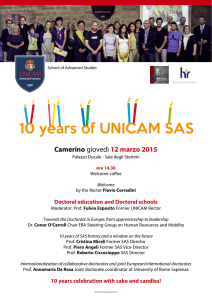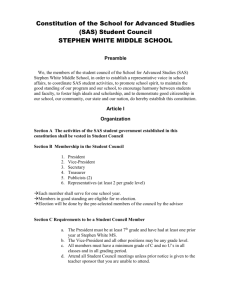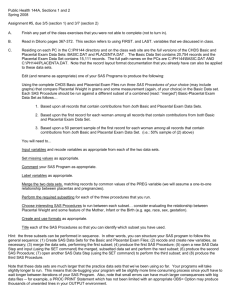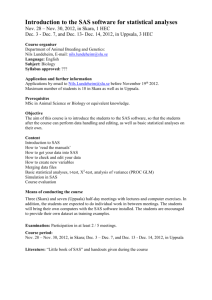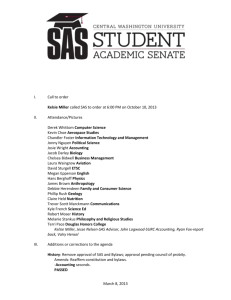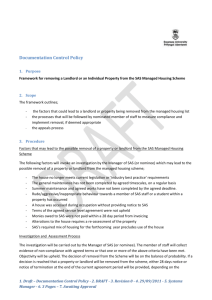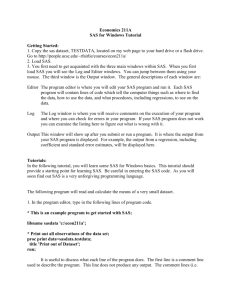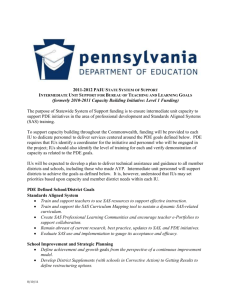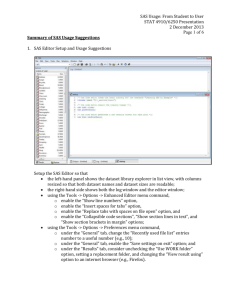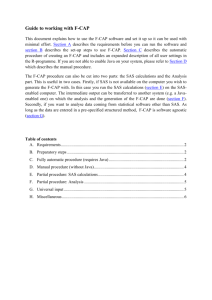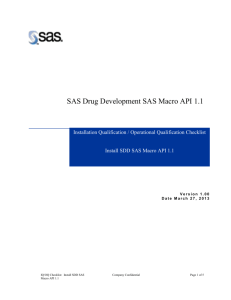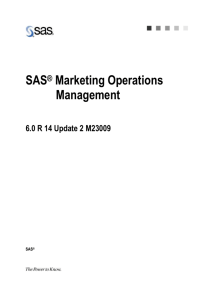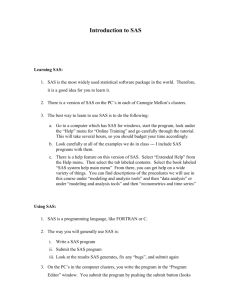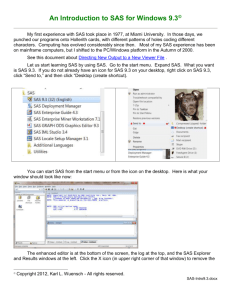STT 646: Statistical Methods for Engineers I
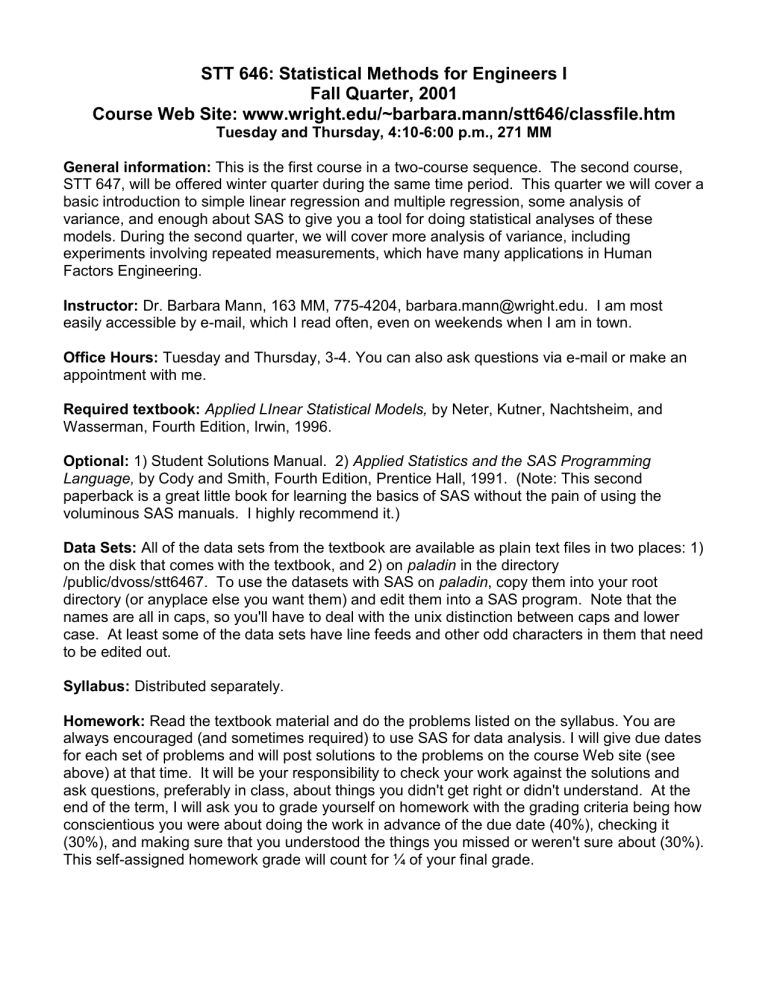
STT 646: Statistical Methods for Engineers I
Fall Quarter, 2001
Course Web Site: www.wright.edu/~barbara.mann/stt646/classfile.htm
Tuesday and Thursday, 4:10-6:00 p.m., 271 MM
General information: This is the first course in a two-course sequence. The second course,
STT 647, will be offered winter quarter during the same time period. This quarter we will cover a basic introduction to simple linear regression and multiple regression, some analysis of variance, and enough about SAS to give you a tool for doing statistical analyses of these models. During the second quarter, we will cover more analysis of variance, including experiments involving repeated measurements, which have many applications in Human
Factors Engineering.
Instructor: Dr. Barbara Mann, 163 MM, 775-4204, barbara.mann@wright.edu. I am most easily accessible by e-mail, which I read often, even on weekends when I am in town.
Office Hours: Tuesday and Thursday, 3-4. You can also ask questions via e-mail or make an appointment with me.
Required textbook: Applied LInear Statistical Models, by Neter, Kutner, Nachtsheim, and
Wasserman, Fourth Edition, Irwin, 1996.
Optional: 1) Student Solutions Manual. 2) Applied Statistics and the SAS Programming
Language, by Cody and Smith, Fourth Edition, Prentice Hall, 1991. (Note: This second paperback is a great little book for learning the basics of SAS without the pain of using the voluminous SAS manuals. I highly recommend it.)
Data Sets: All of the data sets from the textbook are available as plain text files in two places: 1) on the disk that comes with the textbook, and 2) on paladin in the directory
/public/dvoss/stt6467. To use the datasets with SAS on paladin , copy them into your root directory (or anyplace else you want them) and edit them into a SAS program. Note that the names are all in caps, so you'll have to deal with the unix distinction between caps and lower case. At least some of the data sets have line feeds and other odd characters in them that need to be edited out.
Syllabus: Distributed separately.
Homework: Read the textbook material and do the problems listed on the syllabus. You are always encouraged (and sometimes required) to use SAS for data analysis. I will give due dates for each set of problems and will post solutions to the problems on the course Web site (see above) at that time. It will be your responsibility to check your work against the solutions and ask questions, preferably in class, about things you didn't get right or didn't understand. At the end of the term, I will ask you to grade yourself on homework with the grading criteria being how conscientious you were about doing the work in advance of the due date (40%), checking it
(30%), and making sure that you understood the things you missed or weren't sure about (30%).
This selfassigned homework grade will count for ¼ of your final grade.
Exams and Grades: There will be 3 exams, each worth ¼ of your final grade. The first exam will be on Thursday, Oct. 4, the second is tentatively on Tuesday, Oct. 30, and the third is on
Tuesday, November 20. A final average of at least 90% earns an A, 80% a B, 70% a C, and
60% a D.
Autobiography: I always like to know who my students are, what exposure to statistics they have already had, and where they are headed. So I would like to have you hand in next class period a brief autobiography filling me in on these things and whatever else you think I would find interesting or useful. I would appreciate it if you type or word-process it. Please also include your preferred e-mail address and give me a clue about how well you know your way around unix computers. Here's a sample:
I grew up in Oak Ridge, Tennessee, and did undergraduate work in mathematics at the University of Tennessee (now known as UT-Knoxville). After obtaining a master's degree in Math from Tulane
University, I moved to a small town in southern West Virginia, where I taught mathematics at Concord
College for about 10 years. As happens to so many Wright State students, I decided to do a career change and went back to school at Virginia Tech for a Ph.D. in statistics. Since then, I have been on the faculty in the Dept of Mathematics and Statistics at Wright State. For 11 years, I was Director of the
Statistical Consulting Center, which provides statistical assistance to faculty and graduate students doing research. I stepped down from that position in 1993 to take over the role of Graduate Advisor for the
Applied Statistics Masters degree program. In 1994 I was appointed Associate Director of the Research
Division of the Dept. of Family Medicine and had a half-time appointment in that department until last year. I am currently a full-time Professor of Statistics.
I live in the rather remarkable town of Yellow Springs with my two Airedale terriers, Barney and Gus and my "Aussiedale", Parker. The dogs go with me a couple of times a week to the
Dayton Dog Training Club, where I am the current President, train, and teach an advanced class.
Barney has earned three obedience titles and has recently retired to become a serious couch potato. Gus has one title, but is not real thrilled about doing obedience. He is, however, a serious hunter and has bagged a fair collection of "varmints", including one skunk. I also work with Airedale Terrier Rescue and Adoption, bailing Airedales out of animal shelters, moving them to foster homes so that they can be evaluated prior to putting them up for adoption, and occasionally fostering one myself. Parker (otherwise known as Miss Nosy Parker) is a mixed breed dog I rescued from the Fairborn animal shelter as part of this activity. She is part Airedale and part something else (I speculate that the other half is Australian shepherd) and is a very energetic and trainable youngster - my next obedience and agility dog.
My other hobby is music - I play baroque and renaissance recorders with a group of friends and love all sorts of classical music - from string quartets to opera.





